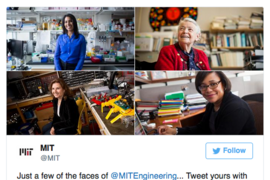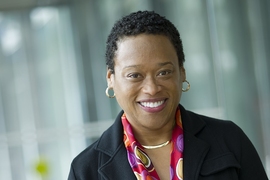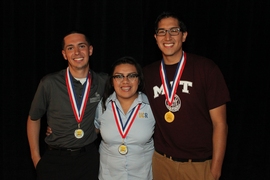For MIT junior Luzdary Ruelas, being selected to attend the national conference of the Hispanic Association of Colleges and Universities (HACU) over Columbus Day weekend was thrill enough. Ruelas was one of 10 students who attended the conference, along with associate dean and director of the Office of Minority Education (OME) DiOnetta Jones Crayton. After the students gathered at Logan Airport for the Miami-bound flight, Crayton surprised them with some news: “She told us right before we got on the plane that MIT was receiving an award, so it was pretty exciting!” Ruelas says.
Crayton was surprised by the recognition, as well, when she was notified this summer. “We didn’t even know we were eligible for the award,” she says. The award names MIT as the 2015 Outstanding Associate HACU-Member Institution, given in honor of “the extraordinary efforts and success of an institution that has excelled in advancing the mission and goals of HACU.” MIT was selected from a pool of 105 HACU associate member institutions from 28 states and the District of Columbia. (Associate membership — one of four categories of membership — includes institutions that have at least 10 percent Hispanic enrollment; among all membership categories, HACU has over 480 member institutions.)
In her acceptance speech, Crayton expressed how “deeply grateful and humbled we are to receive the Outstanding Associate-Member Institution Award. MIT has a long-standing commitment to diversity, and this award is both a testimony to our efforts and a challenge to us as well … a challenge to not only sustain but to surpass the standards that we have set for the Institute in the area of diversity and inclusion.”
“I am very proud of DiOnetta and the entire OME team for turning our commitment to diversity into actions, and for ensuring that MIT’s values are on full display for our community and colleges across the country to see,” Chancellor Cynthia Barnhart says. OME is part of the Office of the Dean for Undergraduate Education, which reports to the chancellor.
Going all-in
Since joining HACU in 2013, OME has been an active participant and thought-partner in the association’s meetings, forums, events, and conferences, and has enabled a number of students to attend the Student Track of HACU’s national conferences. “We’ve accomplished a lot in two years,” says Crayton, noting that — in true MIT fashion — OME went all-in from the get-go. “For us, if we’re going to have a relationship with any organization, we want it to be an active relationship. … We wanted to get our students engaged sooner rather than later.”
In addition to this year’s cohort, OME has sent 10 students to the 2013 and 2014 national conferences, and three to HACU’s international conference in Guadalajara, Mexico, in February of this year. Students participate in the Student Track program, which includes workshops, seminars, and networking opportunities with representatives from industry, government, and graduate schools.
This year, 465 students from around the U.S. attended the HACU conference. “It was really cool to be with so many other Hispanic students from colleges from everywhere,” Ruelas says. And although she learned a lot in the Student Track sessions, just sharing experiences with other students was an eye-opener. “Out of all the colleges, I think the only Ivy-plus schools that attended were MIT and Cornell. So it was interesting to see how the struggles we face are sort of similar to the struggles that other students in community colleges or state schools face,” she says.
Ruelas’s experience with HACU is one example of the kind of engagement OME strives to cultivate. “We’re invested in keeping our students connected to their heritage and their education,” Crayton says. “We want them to know that the issues that Latinos face in other universities may not necessarily be the same ones that they face here, but we want them to be knowledgeable and aware of those issues.” One example is the impact of immigration reform on undocumented students who grew up in the U.S. The issue is all too real for some MIT students — so much so that they founded DreaMIT, an on-campus organization to help undocumented students navigate the unique challenges they face at the Institute.
More work to be done
About 24 percent of MIT’s undergraduates are underrepresented minorities, consisting of Hispanic/Latino, Native American, and African American students. The largest group, Latino students, makes up 14 percent of the undergraduate population and 5 percent of graduate students. These numbers have grown steadily in the past decade, and MIT compares favorably to its peers — particularly STEM institutions — according to Edmund Bertschinger, the Institute community and equity officer and a professor of physics.
But there is more work to be done, he says. “We have a lot to learn from Hispanic-serving institutions, and the award is an acknowledgement that we can help others.” Bertschinger, whose office frequently collaborates with OME, participated this year in the HACU deans’ forum on strategies for diversifying faculty.
“Hispanic-serving institutions are the most rapidly growing component of higher education, and the vast majority of those institutions have nothing like the financial and intellectual resources that we do,” Bertschinger says. “When our colleagues recognize that we are striving to lead not only in discovery and innovation, but also in the empowerment of people of every race and ethnicity, that gives encouragement to everyone.”
For Crayton, part of the significance of the award is that it conveyed a deeper message to other institutions at the HACU conference. “It was important for them to know how diverse MIT is,” she says. “It was also important for them to know that the largest underrepresented minority group at MIT is Latino students. Yes, Latino students attend Hispanic serving institutions, but there are talented Latino students at MIT, as well. Hopefully, the students and professionals at the conference were inspired, and they got to see a side of MIT that they didn’t even know existed.”












